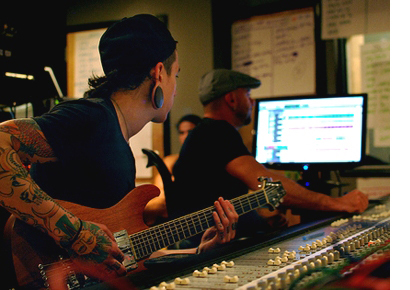The world may not revolve around guitar music anymore, but there is still a lot of it out there. Whether you’re working on face melting hardcore or a gentle country ballad, the presentation of the guitar content in the mix has a lot to do with the overall stylistic impression of the song.
Here are a few tried and true techniques for working with guitar tracks:
Hear the Arrangement

Some guitar tracks are played and recorded to stand out as focal points in the mix. Other guitar parts are intended to work as tonal layers of another instrument. Before you dive into the mix (or even the tracking session), take a moment to consider why each guitar track exists.
You’re probably going to come up with one of three answers:
- It’s a musical focal point, a source of interest and energy in the song
- It’s a rhythmic element that adds tonal complexity to a percussive instrument
- It’s not musically functional at all (and should be muted).
With your answer in mind, you’ll have a great benchmark for evaluating the guitar parts within the mix, as opposed to evaluating them as individual elements.
Pick a Level Before You Pick a Tone
With musical function in mind, decide what the basic balance structure is going to be between the guitar elements and the drum and/or vocal content.
If your guitar tracks are co-stars of the arrangement, they’re going to be loud. Reference how loud ‘loud’ guitars are in effective mixes within the same musical genre. The answer will vary widely. I’d suggest referencing guitar level compared with the vocals (assuming there is one) and the loudest drum content.
If your guitar tracks are supporting players in a layered tone, start by establishing the internal balance relationships within the layered sound. For example, if your guitar part was played to brighten a piano idea, establish that basic balance before you try to balance the layered effect within the mix.
Once the layers are roughed in (compared with one another), use an audio subgroup or fader group to easily balance the layered tone within the main mix.
Approach Panning as Part of Leveling
Carefully consider how the panning of your guitar tracks affects their balance relationships.
The loud, dominant guitar tracks in any hardcore genre that include vocals are an easy example. Since the guitars are supposed to be ‘loud’ compared with the vocal, they are usually panned far left and/or right to avoid obscuring the vocal altogether. Otherwise, one might be tempted to raise the vocal level, which would reduce the impact of the guitar content. Think of this as mixing (panning) for separation, in order to preserve distinct balance choices.
On the other hand, if your guitar track is “part of” another instrument’s sound you might consider panning to avoid musical separation. Keeping such musical layers panned together or symmetrically opposed helps maintain the aural illusion that they are tonal components of a single instrument. You’re simply deciding whether that’s going to be a mono or stereo instrument.
Refine the Tone of Your Guitar Content ‘In Place’
With the musically essential choice about function established by rough balance and reinforced by smart panning, it makes sense to address how the harmonic content of the guitar tracks can be optimized.
There’s no point in pretending to relate EQ specifics (or even most generalities), but if the guitar tracks you’re working with haven’t already fallen victim to knob twisting, there are some themes that might help organize your decision-making.
The fundamental frequencies of the guitar lay largely between 160Hz –1300Hz. In reality, your typical rock or country rhythm track is probably played in the 160Hz-700Hz range.
This frequency band will provide ‘fullness’, ‘warmth’, or even ‘muddiness’ when accentuated. The same range can be attenuated to get thinner, less supported tones. Try starting in the 350Hz-500Hz range with your center frequency.
Boosting a wide peak approximately two octaves above the fundamental frequency center can very easily, naturally brighten picked performances on metal-stringed instruments. This is the frequency range in which these instruments are naturally bright, so it pays to play along.
Below about 80Hz even the most theoretical harmonic contribution to your guitar sound has been exhausted. Don’t hesitate to high-pass filter guitar tracks to prevent non-programmatic low frequency content from messing with your gain staging and dynamics control.
Working From a Musically Relevant Basis
Notice we haven’t touched a single multi-band compressor or 8-bit distortion-cruncher-thing. Tricks aren’t tricks unless the tracks are working in the arrangement (i.e. for the song). Starting with these types of basic considerations can take decent tracks most of the way to musical effectiveness, and take excellent tracks all the way.
For more articles about recording, mixing, and production visit The Pro Audio Files, brought to you by Dan Comerchero.


